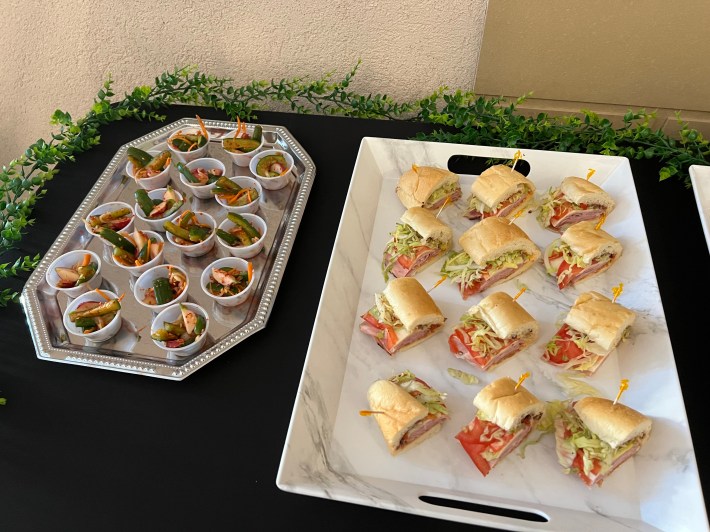The Wanderer’s Curse x Gentle Foods
Philbrook Museum of Art
May 22
The faint, oceanic fragrance of kimchi hung in the air in Philbrook’s guest lounge, whose floor-to-ceiling glass windows illuminated the little cups of fermented cucumber and radish—a thing in a place I never thought I would see (or smell). It made me feel at home; one whiff hurled me into the serenity of congruity despite being in a hall full of complete strangers. Even Walmart sells kimchi now, so I should probably learn to tamp that feeling down.
“Koreans are everywhere,” said food writer Christina Chaey—formerly of Bon Appétit and currently of the popular Substack Gentle Foods—as she led a book talk in the Philbrook gardens with award-winning Bon Appétit editor and Tulsa Artist Fellowship alum Jennifer Hope Choi about Choi’s new memoir, The Wanderer’s Curse.

Chaey, who prepared the food for the event, said she ordered sub sandwich bread from a local Bill and Ruth’s, and when she went to pick it up, the employee said, “Are you Korean?” And then, “So am I.”
What are the odds? How strong are the ties that bind? Are we really more alike than unalike? What do we make possible by recognizing or rebelling against our likenesses? In art, what’s the difference between saying, “I am Korean,” and just saying, “I am,” while being Korean? Chaey and Choi dug through the macro and micro layers of questions like these, which inform both their work, for about an hour to a crowd of a few dozen people.
Choi’s book is titled after a translation of yeokmasal, a nomad’s curse in Korean cultural lore that may or may not be hereditary and may or may not only be diagnosable by a fortune teller, a common practice in Korea still. On its face, The Wanderer’s Curse is a mother-daughter story, with Choi exploring her defiant history of feeling nothing like her mother, her Umma—until she did.
Likeness and difference, like closeness and distance, are complicated to map. Choi read an excerpt from her book in which she parallels the loss of her beloved cat with the loss of her mother’s dog. To the first event, her mother responded, “We all gotta go sometime. It’s a facts [sic] of life,” while patting Choi on the back. But Umma documented her own dog’s passing with a series of wailing photos from the euthanasia appointment, maybe as passive proof she was capable of the depths of grief someone less stoic might display. In the book, this follows a series of brief texts from Umma asking Choi to move in with her, including one that reads, “Lov u. We r so much alike it is scary.”
The Wanderer’s Curse is a story about creative restlessness, as much as it is about family restlessness. Choi talked about her history with writing fellowships and grants, commending the Tulsa Artist Fellowship as one that illustrated what it might look like to “live as an artist,” which she and Chaey then dissected. More than a curse, the title of the book, Choi said, is about finding a home in artmaking and not knowing where it will lead, except to possibility: “the delusion of pursuing something you feel purposeful in.” Chaey called it “living with the uncertainty of forging our own ways” and touched on the “opportunity costs” of the life a person chooses to live.
Despite her best efforts to not write about herself, Choi said, the book really is about her and not falling into the trap of exploring immigrant guilt: not writing an “Asian book,” as a literary agent once said to her. They talked about that trap, as well as the “smelly lunchbox” trope—that is, one of our Asian-American collective traumas is being mocked for the food we ate as children in America and then coming around to acceptance of what that food means to us—as ideas they had both received pitches about and had written about themselves.
This all raised some questions for me about my own writing and how it ties into my identity as a first-generation Korean-American. As a country, the U.S. is in the midst of accepting Koreanness as a unique identity (see again: kimchi at Walmart, which I never would have imagined as a child, or K-Pop getting its own Billboard Award category). So why are we still reaching for these collective tropes when we’re writing? Though everyone knows about us now, consumes our media and our food, we still feel the pull to explain our existence. Maybe we recognize that we lack the assumed context afforded to writers who don’t look like us—or are trying to differentiate ourselves from writers who do. Maybe we’re clinging to our similarities because there is power in numbers, or because we still remember the cultural isolation that shaped us.
Chaey pointed out a need for nuance. Even if we look very similar on paper, Korean-Americans are not a monolith, she pointed out, then asked a harder question: “Is there room for that?” If a woman I’ve never met recognizes the subtle hangeul embroidery on my Nikes at a book talk, if a Tulsa Artist Fellow stamps her books with a dojang, and if Philbrook can serve kimchi alongside “Korean church basement” sub sandwiches and a cookie modeled after the results of a reading of Choi’s saju, I’d argue yes.






